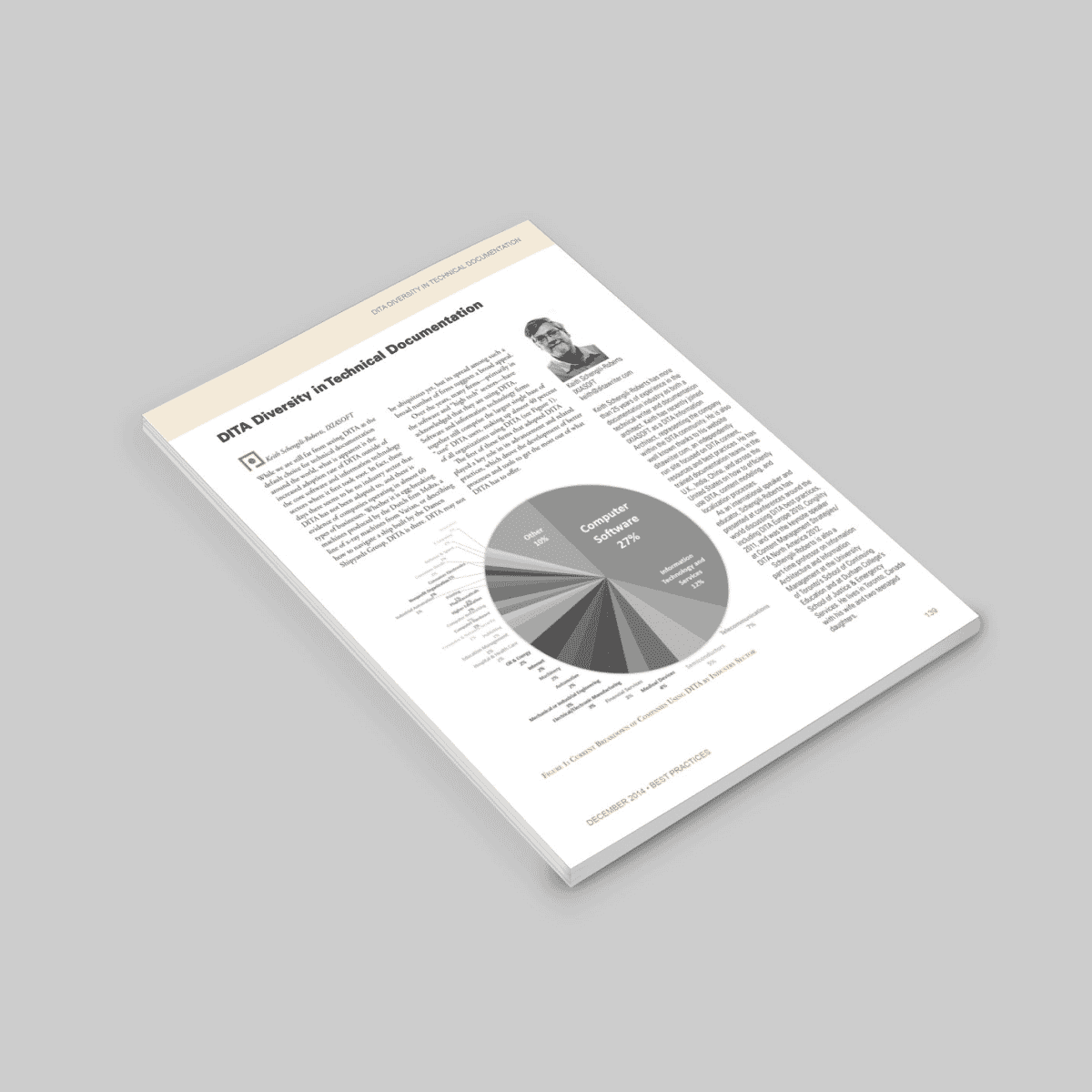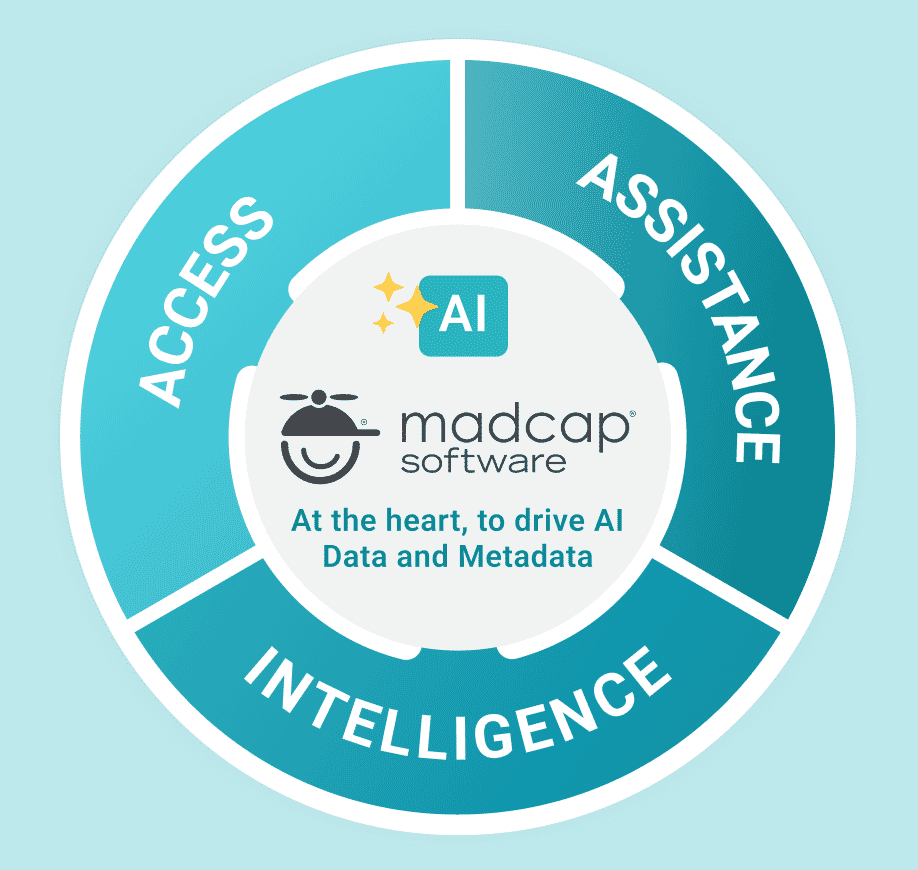DITA Diversity in Technical Documentation

Keith Schengili-Roberts has more than 25 years of experience in the documentation industry as both a technical writer and documentation architect. Keith has recently joined IXIASOFT as a DITA Information Architect, representing the company within the DITA community. He is also well known thanks to his website ditawriter.com, an independently run site focused on DITA content, resources and best practices. He has trained documentation teams in the U.K., India, China, and across the United States on how to efficiently use DITA, content modeling, and localization processes.
As an international speaker and educator, Schengili-Roberts has presented at conferences around the world discussing DITA best practices, including DITA Europe 2010, Congility 2011, and was the keynote speaker at Content Management Strategies/ DITA North America 2012. Schengili-Roberts is also a part-time professor on Information Architecture and Information Management at the University of Toronto’s School of Continuing Education and at Durham College’s School of Justice & Emergency Services. He lives in Toronto, Canada with his wife and two teenaged daughters.
While we are still far from seeing DITA as the default choice for technical documentation around the world, what is apparent is the increased adoption rate of DITA outside of the core software and information technology sectors where it first took root. In fact, these days there seems to be no industry sector that DITA has not been adapted to, and there is evidence of companies operating in almost 60 types of businesses. Whether it is egg-breaking machines produced by the Dutch firm Moba, a line of x-ray machines from Varian, or describing how to navigate a ship built by the Damen Shipyards Group, DITA is there.
DITA may not be ubiquitous yet, but its spread among such a broad number of firms suggests a broad appeal. Over the years, many firms—primarily in the software and “high tech” sectors—have acknowledged that they are using DITA. Software and information technology firms together still comprise the largest single base of “core” DITA users, making up almost 40 percent of all organizations using DITA (see Figure 1). The first of these firms that adopted DITA played a key role in its advancement and related practices, which drove the development of better processes and tools to get the most out of what DITA has to offer.
The Role of Early Adopters
It all started with IBM and their pioneering efforts with topic-based authoring, which they released to OASIS as an open standard, leading to the first published DITA standard back in June 2005. From there it spread to numerous early adopters, such as Research in Motion/ BlackBerry (telecommunications), AMD (semiconductor), and Siemens Medical (medical devices). While the promise of content reuse appealed to a variety of firms, only software and other high-tech companies initially had the tools at hand to take full advantage of it.
In these early days of DITA adoption, there were many companies that appropriated the version control programs already used by software developers (CVS, Perforce, and Subversion to name a few) to store and manage their DITA topics. Many technical writers using this type of proto-content management system learned how to lock their content, branch versions of it and release it in a similar manner that software developers had been doing with their code for years. These same operations persist in many mature DITA-based content management systems today, derived from processes that worked well in the early days of DITA adoption.
Need for Metadata-Based Search
There are still a number of companies using version control software today and while it is excellent for tracking code, it was not designed for handling operations that involve documents with hundreds or even thousands of topics. There was a need for improved metadata-based search and processes to maximize localization efficiency, as well as to deal with complex publication processes. Many early adopters would go on to develop DITA best practices and play an active part in the development of better tools supporting DITAbased technical documentation. Initially those DITA tools were adopted from previous XML standards, such as SGML, DocBook, and S1000D.
My first exposure to a DITA-capable CMS was XyEnterprise Contenta for DITA, which started out as a publication system for handling SGML and XML content before being bought out by SDL in 2009 (and later repositioned for use exclusively for S1000D). Similarly, Trisoft InfoShare emerged in the pre-DITA days as a CMS for general XML-based documentation, later evolving under the guidance of SDL to become the DITAspecific SDL LiveContent. XML-repository TEXTML Server from IXIASOFT was chosen as the basis for a DITA-based toolchain that ATI (later AMD) wanted, and from that IXIASOFT DITA CMS was born. Correspondingly, a number of products have been adapted in the XML editor marketplace and then optimized for use with DITA, including Arbortext, XMetaL, and oXygen.
Growing Demand for DITA
The growing popularity of DITA has provided a boost to other firms with XML-based tools, ranging from output/ formatters like Antenna House Formatter and RenderX, conversion tools like DITA2Go, or migration tools such as Migrate from Stilo. The current mature tool marketplace is the direct result of purchase decisions made by the first wave of DITA adopters from the mid-2000s.
The early DITA-adopting firms have acted like incubators, with the members of their technical writing teams spreading to an evergrowing number of other firms. However, this process is not inevitable. During my research, I came across many cases of when people used DITA at one firm, but not at the next company where they worked, or even the next one after that. Nevertheless, there is a strong correlation between people who have DITA experience at one firm and the chances that they will go on to pilot DITA efforts at their next place of employment. Best practices in technical documentation learned at one firm tend to be carried over to the next, and so on, another significant factor in the spread of DITA usage over time.
Mini Case Study: Nokia
The best example of this I could find was the slow diffusion of DITA talent over the years from Nokia. Nokia was a very early adopter of DITA, starting their efforts back in 2004 with what appears to have been a very broad implementation of DITA across the technical writing teams, across the company worldwide. Figure 2 depicts all of the companies that have been influenced by the dispersal of people who first gained DITA experience at Nokia and then went on to use these skills at the other firms depicted.
There are more than 30 DITA-using firms that hired people who first learned DITA while at Nokia. In cases like Nokia-offshoot HERE and Microsoft (which acquired Nokia) they qualify more as cases of “same cubicle, different t-shirt”, but there are many more instances of people who have taken their DITA knowledge from Nokia and have either helped launch DITA initiatives at other firms, joined consulting companies that assist other organizations with their DITA implementation, or have been hired due to their extensive DITA experience at a firm already established in DITA-based documentation practices.
How Widespread Is DITA Usage
Given mature processes, toolsets, and an alltoo-common need to make documentation processes as efficient as possible, it was really only a matter of time before DITA usage started to pick up steam outside of its core base. So how widespread is DITA usage? My estimates are rough, but based on data derived from LinkedIn references correlated to American job listings on Indeed.com, it appears that about 5 percent of all technical writers are using DITA. There are approximately 150,000 technical writers listed on LinkedIn with 8,000 claiming DITA knowledge, which comprises 5 percent of the whole.
On my DITA-industry focused web site, DITAWriter.com, there are roughly 450 companies listed that use DITA, a figure derived from roughly 1,200 individual technical writers claiming current DITA experience on LinkedIn. Depending on the ratio of technical writers to companies, this information implies that potentially 1,400 – 3,000 firms worldwide are currently using DITA. These numbers may seem small when compared to the whole technical communications industry, but consider that only about 15 percent of all of the technical writers on LinkedIn claim FrameMaker experience, which has been a cornerstone of professional documentation software for almost a quarter of a century. And then consider the fact that DITA has existed for less than half of that time.
The pace at which DITA is spreading outside of its core software/high-tech sectors also appears to be picking up. It has already made significant inroads into the Telecommunications sector (including Sandvine, Nokia, Huawei, and Ericsson to name a few), Semiconductors (ARM, Infineon, Altera, Intel, Freescale, and many more), and the Medical Device sector (Varian, GE Healthcare, Boston Scientific, Bayer, and CareFusion among others), together comprising 18 percent of known companies using DITA. There are over 20 sectors represented among DITA-using firms, each comprising 1 percent – 3 percent of the overall total.
The following list contains these sectors along with a couple of representative companies whose technical writing departments are known to be using DITA:
- Electrical/Electronic Engineering (Schneider Electric, Raymarine)
- Financial Services (MasterCard, VISA)
- Machinery (Caterpillar, Komatsu)
- Mechanical or Industrial Engineering (Danfoss, HIAB)
- Automotive (Renault Trucks, Tata Motors)
- Oil and Energy (Schlumberger, Chevron, Siemens Wind Power)
- Internet (eBay, PayPal)
- Education Management (Blackboard, Kaplan)
- Publishing (Oxford University Press, Triumph Learning)
- Computer and Network Security (McAfee, CyberSafe)
- Higher Education (Indiana University, Thompson River University)
- Printing (Yamagata, Jyocera)
- Computer Hardware (Cray, Epson)
- Computer Networking (Cisco, Brocade)
- Nonprofit Organizations (UNICEF, World Agroforestry Centre)
- Pharmaceuticals (Elekta, Abbott)
- Consumer Electronics (Dolby, Brother)
- Consumer Goods (Electrolux, BRP)
- Defense and Space (L3 Wescam, SDI)
- E-Learning (Complete Curriculum, WebAssign)
- Insurance (California Casualty, ICBC)
After these sectors come the “Other” category, comprising 11 percent of all firms using DITA. While the numbers are small—over 20 industry sectors, sometimes with only a single firm representing an industry sector—the diversity represented strongly suggests that DITA is moving into a new phase of wider adoption. These additional sectors include:
- Aviation & Aerospace (Delta Airlines, Insitu)
- Research (National Cancer Institute, U.S. National Library of Medicine)
- Broadcast Media (Grass Valley)
- Entertainment (DeNA)
- Government Administration (U.S. Veterans Health Administration)
- Human Resources (ADP)
- Maritime (Kongsberg Maritime)
- Package/Freight Delivery (Fedex)
- Renewables & Environment (Vestas)
- Staffing and Recruiting (Adecco Group)
- Utilities (Dominion)
- Wireless (HTC)
“Success Is the Sum of Small Efforts, Repeated”
This quotation from Robert Collier sums up why DITA—or DITA ways of thinking— are becoming pervasive in the technical documentation world. Certain needs will always be a driving factor in pushing companies to consider adopting DITA, especially the need for efficient content reuse and consistency. Its built-in adaptability through specialization has also helped people extend the functionality of DITA into niche areas. I also believe that the simplicity of topic types in DITA made it a relatively easy way to enter structured authoring, and its minimalist writing principles “clicked” with a lot of technical writers. I think this is why DITA has taken off in the way that it has: writers from an initial DITA implementation at one firm eventually move on to other companies and bring the idea of using DITA with them. In this way, there has been a “cross pollination” of DITA usage outside of the original software sector to every other sector it has touched.
Tools supporting DITA have matured, allowing more and more companies outside of the software/ high-tech sectors to take full advantage of the standard. We are witnessing the definite end of the early adopter stage of DITA usage and have moved into the early majority phase. There is clear evidence of increasing diversity in firms using DITA and their use of mature tools and best practices bequeathed to them by the early adopters. It is safe to say that we will see continued growth in the use of DITA worldwide over the next few years.

About the Author
Keith Schengili-Roberts
Senior DITA Content Strategist on the MadCap IXIA CCMS team




